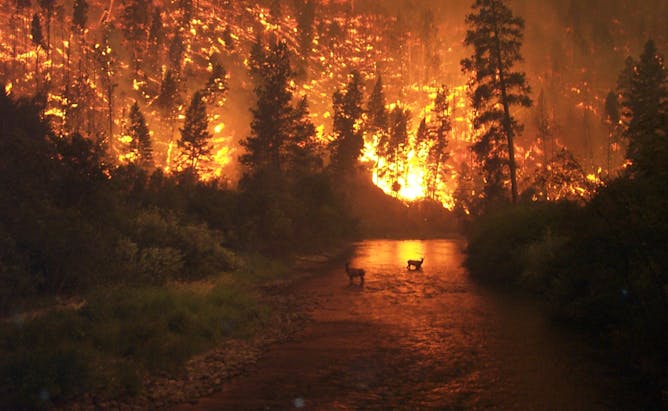|
With Earth Day coming up on Saturday, The Conversation has been exploring some of the profound changes underway as the planet warms, from threats to sea life when El Niño arrives on top of record high ocean temperatures, to the growing flood risk from extreme storms. Today, we’re looking to the mountains and the rising risk of wildfires.
The high mountains of the western U.S. have long been considered too wet to burn – firefighters could count on the flames quickly dying out. But that’s changing. In a new study, climate scientists and engineers Mohammad Reza Alizadeh of MIT and Mojtaba Sadegh of Boise State University show how fire danger is rising fast in the high mountains, with harmful effects on ecosystems and the millions of people living downstream.
Also today:
|

Fires are increasing in high mountain areas that rarely burned in the past.
John McColgan, Bureau of Land Management, Alaska Fire Service
Mohammad Reza Alizadeh, Massachusetts Institute of Technology (MIT); Mojtaba Sadegh, Boise State University
Fires here can affect meltwater timing and water quality, worsen erosion that triggers mudslides, and much more, as two scientists explain.
|
Health + Medicine
|
-
Amie Ashcraft, West Virginia University
The increase in abortion restrictions may also lead to a decline in access to emergency contraceptives.
|
|
Politics + Society
|
-
Krista Wiegand, University of Tennessee
The South China Sea is of strategic and economic importance to Beijing and the US, setting up a potential power struggle that could spark conflict.
-
Jamie Levine Daniel, Indiana University
Political situations in both Israel and the US could be changing prior patterns with these donations, which fund hospitals, museums and a wide array of organizations.
-
Graham Wright, Brandeis University; Sasha Volodarsky, Northeastern University
We often talk about the American political landscape as if it were a line – Democrats on the left, Republicans on the right. Two political scientists say that view doesn’t reflect reality.
|
|
Economy + Business
|
-
Bryan Keogh, The Conversation; Matt Williams, The Conversation
House Speaker Kevin McCarthy agreed to raise the debt ceiling – and avoid an unprecedented US default – but only if Democrats agree to freeze spending and agree to several other demands.
|
|
Science + Technology
|
-
Mark R. O'Brian, University at Buffalo
Preventive and therapeutic vaccines both train the immune system to fight disease, but they are used in different ways.
-
Eric Smalley, The Conversation
Generative AI can seem like magic, which makes it both enticing and frightening. Scholars are helping society come to grips with the potential benefits and harms.
-
David Liu, Harvard University
Chemist David Liu explains how gene editing is paving the way to treating and even curing certain genetic diseases.
|
|
Ethics + Religion
|
-
Casey Fiesler, University of Colorado Boulder
Generative AI is designed to produce the unforeseen, but that doesn’t mean developers can’t predict the types of social consequences it may cause.
|
|